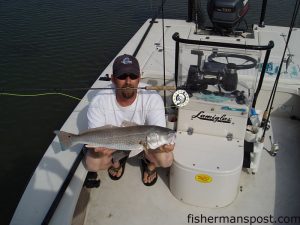Road To Redfish – On-The-Water Line Management
After several articles dealing with the many aspects of fly fishing, Gary Hurley and I actually made it out on the water in my flats skiff to do some on-the-boat fly casting and fishing. Each article so far has dealt with a specific aspect of fly fishing (such as casting techniques, rod selection, or general rigging for redfish), and this article continues in that tradition, focusing on line management while standing in the front of the boat.
Gary and I both felt that we needed to get out on the water (any excuse really) and put to use all of the different pieces of the puzzle in actual fishing situations. The reason for “real life” experience is because until you are standing on the bow of a flats skiff managing your line on the deck and in your hands, all the while trying to set up and present a fly to a redfish or a “fishy looking” spot, you will never truly appreciate the necessity of practice.
Practicing in a field or parking lot will absolutely help to improve your casting stroke. And the more you do it, the more “automatic” it will become. And the more “automatic” your cast is, the easier it will be for you to deal with all of the factors that may, and probably will, arise while you are actually trying to fish.
Line management is definitely one of the biggest obstacles to getting a cast off in time and in the right direction to have a chance at coming tight on a red. Fifty feet would be a common distance for a redfish cast, and that means that there will be forty feet or so of line on the deck before a cast. Forty feet of line, as you can imagine, is just waiting to tangle or get caught on something, anything really.
You would be amazed. Just ask Gary. Line management starts with a properly stretched fly line, and to achieve this you take four or five feet of line at a time between outstretched arms and apply a light steady pull to relax the memory in the line from being on the reel. This helps keep twists and knots to a minimum.
For a right handed caster, the left hand becomes a line management tool, so to speak, and aids in every aspect of fly fishing from beginning to end. For line management, the left hand is in control, and you use it to regulate the amount of line outside of the rod tip, line speed (by way of the double haul to be discussed in detail later), and clearing line off of the deck after it is “shot” during a cast or even pulled by a hooked fish.
The non-rod holding hand is such an important factor while fly fishing, and becoming comfortable with how to use it is one of the cornerstones of fly fishing. This fact often gets overlooked and can cause proficient casters to be unable to present a fly where needed or in a timely manner.
The thumb and forefinger can be used as an “extra guide” by making a circle and letting line pass through from the deck before reaching the rod guides. This will allow the caster to avoid tangles and also regulate every inch of line that goes through the guides.
Once the casting stroke becomes a more natural series of movements and the non-casting hand is always in control of the fly line, the fly fisher can concentrate on all of the other factors concerning a properly placed cast, like wind, boat direction, desired targets, and a host of other scenarios that we will discuss in the coming weeks as we get closer to our goal of catching a redfish on the fly.
Remember, if you’d like to practice fly casting, then stop by Intracoastal Angler and grab one of our demo rods.
Thanks for reading, and hope to see you on the water!
Capt. Jon Huff is owner operator of Circle H Charters, an inshore fly and light tackle guide service based out of Wrightsville Beach. Jon splits his time between running inshore charters, fishing offshore tournaments, and co-managing Intracoastal Angler. (910) 617-2619, www.circlehcharters.com

